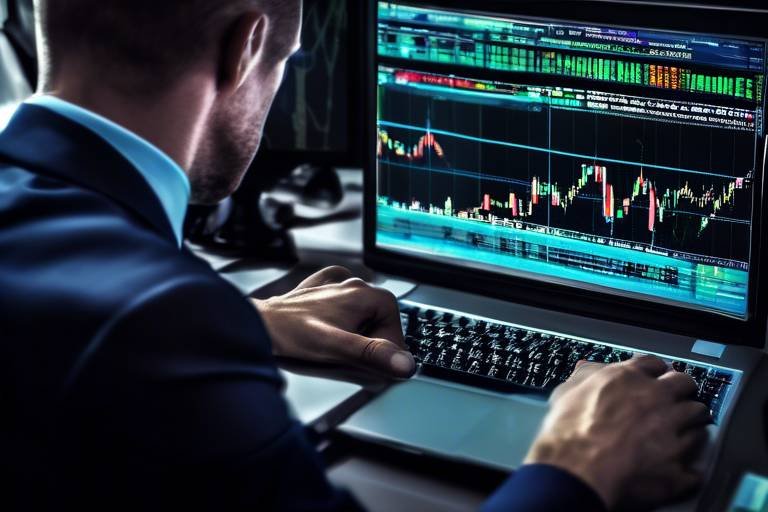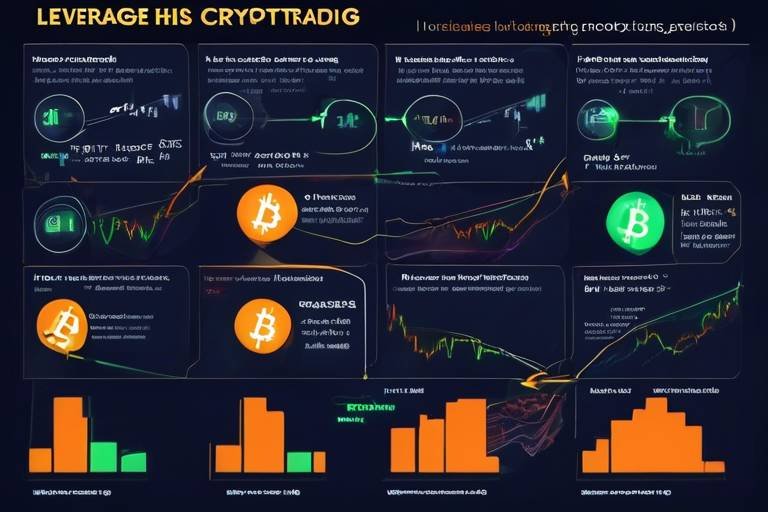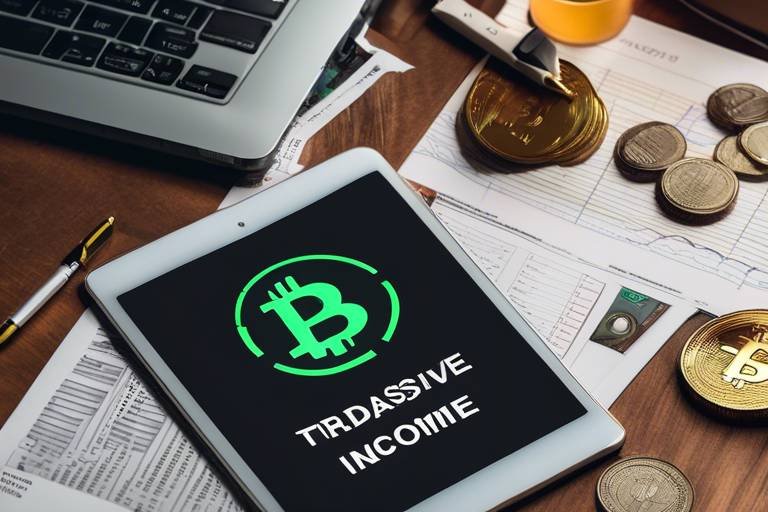The Best Crypto Trading Platforms for 2025
As we step into 2025, the world of cryptocurrency trading is evolving at a breakneck pace. With new platforms emerging and existing ones enhancing their features, the choices for traders are more abundant than ever. But how do you sift through the noise to find the best crypto trading platforms that suit your needs? In this article, we will explore the top contenders expected to dominate the market, analyzing their features, security protocols, fee structures, and overall user experience. Whether you're a seasoned trader or just dipping your toes into the crypto waters, understanding these platforms is crucial for maximizing your trading potential.
Understanding the essential features of crypto trading platforms is crucial for traders. The right tools can make a significant difference in your trading experience. For instance, advanced charting tools allow traders to analyze market trends and make informed decisions. Automated trading options can help you execute trades even when you're not actively monitoring the market. Some platforms offer features like:
- Real-time data feeds for accurate market analysis.
- Customizable dashboards to suit individual trading styles.
- API access for algorithmic trading.
These features not only enhance your trading efficiency but also provide a competitive edge in the fast-paced world of cryptocurrency.
When choosing a trading platform, **security** should be your top priority. The crypto landscape can be fraught with risks, making it essential to select platforms that implement robust security measures. Leading platforms employ a variety of strategies to protect user assets, including:
- Two-factor authentication (2FA) to add an extra layer of security.
- Cold storage for the majority of funds, keeping them offline and away from potential hackers.
- Insurance policies to cover potential losses.
By investing in platforms with these security features, you can trade with greater peace of mind, knowing your assets are well-protected.
Regulatory compliance is vital for the legitimacy of crypto platforms. As regulations become stricter worldwide, it's essential for platforms to adhere to these guidelines. Different platforms operate under various jurisdictions, which can affect how they manage compliance. For traders, this means:
- Increased protection from fraudulent activities.
- Accountability in case of disputes.
- Access to better trading conditions if the platform is well-regulated.
Licensing and registration are indicators of a platform's reliability. Always check a platform's licensing status before committing your funds. A licensed platform is more likely to adhere to regulations and provide a safer trading environment. To verify a platform's licensing, you can:
- Visit the platform's official website for licensing details.
- Check with regulatory bodies in the platform's operating region.
Know Your Customer (KYC) and Anti-Money Laundering (AML) policies are essential for security. These measures ensure that platforms verify the identities of their users, which helps prevent fraud and money laundering. While some traders may find these processes cumbersome, they are crucial for fostering a safe trading environment. By understanding how these policies work, you can appreciate their importance in the overall security framework of crypto trading.
User experience plays a significant role in trading efficiency. A platform with a user-friendly interface can save you time and frustration, allowing you to focus on making profitable trades. Features like:
- Intuitive navigation that makes finding tools and information easy.
- Responsive customer support to resolve issues quickly.
- Mobile accessibility for trading on the go.
are essential in enhancing your trading journey. After all, a seamless experience can be the difference between a successful trade and a missed opportunity.
Understanding fee structures is crucial for cost-effective trading. Different platforms have varying fee models, which can significantly impact your overall profitability. Common fees associated with crypto trading platforms include:
- Trading fees - charges for executing trades.
- Withdrawal fees - costs for moving your funds off the platform.
- Deposit fees - charges for adding funds to your account.
Comparing fees across different platforms can save traders money. We will provide a comparison of fees from popular platforms, helping users identify the most cost-effective options. For example, some platforms may offer zero trading fees but charge higher withdrawal fees, while others might have a flat fee structure. It’s essential to choose a platform that aligns with your trading habits.
Hidden fees can significantly impact profitability. Many traders overlook these costs until it's too late. Common hidden fees include:
- Inactivity fees for dormant accounts.
- Conversion fees for trading between different cryptocurrencies.
Being aware of these potential costs can help you trade without unexpected financial surprises.
Reliable customer support is essential for resolving issues quickly. When trading, you want to know that help is readily available if something goes wrong. Evaluating the customer support options available on various platforms is crucial. Look for platforms that offer:
- Live chat for immediate assistance.
- Email support for less urgent inquiries.
- Phone support for personalized help.
Response times can vary widely among platforms. We will assess the average response times for customer inquiries and how they impact the overall user experience. A platform that responds quickly can save you time and reduce stress, especially during critical trading moments.
Different platforms offer various support channels. By exploring the effectiveness of these channels, traders can choose platforms that meet their support needs. Whether it’s through a comprehensive help center, live chat, or phone support, having multiple avenues for assistance can make a world of difference in your trading experience.
Here are some frequently asked questions that may help clarify your understanding of crypto trading platforms:
- What should I consider when choosing a crypto trading platform? Look for security features, user experience, fee structures, and customer support.
- Are all trading platforms regulated? No, not all platforms are regulated. It's essential to check their licensing and compliance status.
- How can I ensure my funds are safe? Choose platforms with robust security measures like 2FA, cold storage, and insurance policies.
- What are hidden fees? Hidden fees are costs that are not immediately apparent, such as inactivity or conversion fees.

[Platform Features]
When it comes to crypto trading, the platform you choose can make or break your trading experience. In 2025, traders will be looking for platforms that not only offer a wide range of cryptocurrencies but also come equipped with cutting-edge features that enhance trading efficiency. One of the primary features that traders should look for is advanced charting tools. These tools allow traders to analyze market trends, identify patterns, and make informed decisions. Imagine having a crystal ball that helps you predict market movements—this is what advanced charting can feel like!
Moreover, automated trading options are becoming increasingly popular among traders who want to capitalize on market opportunities without being glued to their screens 24/7. With trading bots and algorithmic trading, users can set specific parameters and let the software do the heavy lifting. This is particularly beneficial for those who may not have the time or expertise to monitor the markets constantly.
Another essential feature is the availability of multiple order types. Whether you prefer limit orders, market orders, or stop-loss orders, having these options at your disposal can significantly impact your trading strategy. Think of it like a toolbox—having the right tools can help you tackle any project efficiently.
Furthermore, the integration of mobile trading applications is a game-changer. In today's fast-paced world, being able to trade on the go is crucial. A user-friendly mobile app ensures that traders can execute trades, monitor their portfolios, and stay updated with market news anytime, anywhere. Imagine being able to make a profitable trade while sipping coffee at your favorite café!
In addition to these features, platforms should also provide educational resources for traders, especially those who are new to the crypto space. Webinars, tutorials, and articles can empower users with the knowledge they need to navigate the complex world of cryptocurrency trading. After all, knowledge is power, and in trading, it can lead to profits!
Lastly, let's not forget about the importance of customizable interfaces. A platform that allows users to tailor their dashboards according to their preferences can enhance the overall trading experience. Traders should feel comfortable and in control, much like a pilot flying their own plane through the skies of the crypto market.
In summary, the best crypto trading platforms in 2025 will be those that offer a combination of advanced tools, automation, mobile accessibility, and educational resources. As the crypto landscape continues to evolve, these features will be vital for traders looking to stay ahead of the curve.

[Security Measures]
When it comes to trading cryptocurrencies, security should be at the forefront of every trader's mind. With the rise of digital currencies, the number of cyber threats has also increased, making it essential for trading platforms to implement robust security measures. In 2025, we can expect the best crypto trading platforms to prioritize user safety through a combination of advanced technologies and strict protocols.
One of the most critical security features is two-factor authentication (2FA). This process adds an extra layer of protection by requiring not just a password but also a second form of verification, such as a code sent to your mobile device. This means that even if someone gets hold of your password, they won't be able to access your account without that additional code. Many platforms are now making 2FA mandatory, which is a significant step in the right direction for user security.
Another essential aspect is the use of cold storage for user funds. Cold storage refers to keeping the majority of the platform's assets offline, disconnected from the internet, making it nearly impossible for hackers to access them. Only a small percentage of funds are kept in hot wallets for trading purposes, which minimizes risk. In 2025, expect platforms to enhance their cold storage solutions, possibly even utilizing advanced cryptographic methods to protect these offline assets.
Insurance policies are becoming increasingly common in the crypto space. Some platforms are now offering insurance coverage for user funds, which can provide peace of mind for traders. This means that in the unfortunate event of a breach, the platform may reimburse users for their losses. However, it's crucial for traders to read the fine print and understand the terms of these insurance policies before relying on them.
In addition to these measures, regulatory compliance plays a significant role in platform security. Many reputable exchanges adhere to strict regulations set by financial authorities in their respective jurisdictions. This compliance often involves regular audits and transparency in operations, which can significantly enhance user trust. It's important for traders to choose platforms that are not only compliant but also transparent about their regulatory status.
Regulatory compliance is not just a buzzword; it's a necessity in the crypto trading landscape. Platforms that comply with regulations are often seen as more trustworthy, as they must adhere to strict guidelines that protect users. In 2025, we can expect to see more platforms obtaining licenses from reputable authorities, which will serve as a badge of legitimacy. Traders should always check a platform's compliance status before committing their funds.
Licensing and registration are critical indicators of a platform's reliability. A licensed platform is more likely to follow industry best practices and maintain high standards of security. Traders can verify a platform's licensing status by checking with regulatory bodies or the platform's website. This simple step can save traders from potential scams and fraud.
Know Your Customer (KYC) and Anti-Money Laundering (AML) policies are essential for fostering a secure trading environment. KYC requires platforms to verify the identity of their users, which helps prevent fraudulent activities. AML policies, on the other hand, are designed to detect and report suspicious transactions. In 2025, platforms will likely enhance these policies, utilizing advanced technologies like artificial intelligence to monitor transactions more effectively.
In conclusion, the security measures implemented by crypto trading platforms are crucial for protecting user assets. As the industry evolves, we can expect to see even more sophisticated security features that not only safeguard funds but also enhance user trust. Always prioritize platforms that demonstrate a commitment to security through robust measures and regulatory compliance.
- What is two-factor authentication (2FA)? 2FA is an additional security layer that requires not just a password but also a second form of verification, often a code sent to your phone.
- Why is cold storage important? Cold storage keeps the majority of funds offline, making them less vulnerable to hacking attempts.
- Do all platforms offer insurance for user funds? No, not all platforms offer insurance, so it's essential to check the terms and conditions before trading.
- How can I verify a platform's licensing status? You can verify a platform's licensing by checking with regulatory bodies or visiting the platform's official website.
- What are KYC and AML policies? KYC policies require platforms to verify user identities, while AML policies monitor and report suspicious transactions to prevent fraud.

[Regulatory Compliance]
When diving into the world of crypto trading, understanding regulatory compliance is like knowing the rules of the game before you step onto the field. Compliance ensures that the platforms you choose to trade on are operating legally and ethically, which is crucial for your peace of mind and financial security. Different countries have varying regulations, and each platform must navigate these waters carefully to maintain its legitimacy. For instance, platforms operating in the United States must adhere to strict guidelines set by the Financial Crimes Enforcement Network (FinCEN) and the Securities and Exchange Commission (SEC).
In many cases, regulatory compliance involves obtaining licenses and registrations that signify a platform's commitment to following the law. These licenses not only protect users but also enhance the credibility of the platform. As a trader, you should always look for platforms that display their licensing information prominently—this is a good indicator that they take compliance seriously.
Moreover, compliance with regulations also means that platforms must implement Know Your Customer (KYC) and Anti-Money Laundering (AML) policies. These measures are essential in preventing fraud and ensuring that platforms do not become a haven for illicit activities. KYC procedures require platforms to verify the identity of their users, which adds an extra layer of security but can sometimes feel like a hassle for traders. However, this is a necessary step to foster a safe trading environment.
To give you a clearer picture, here’s a brief comparison of how some well-known platforms handle regulatory compliance across different regions:
| Platform | Region | Compliance Measures |
|---|---|---|
| Platform A | USA | KYC, AML, SEC Registered |
| Platform B | EU | MiFID II Compliance, KYC, AML |
| Platform C | Asia | Local Licenses, KYC, AML |
As you can see, compliance varies significantly depending on the platform and the region in which it operates. Always research and ensure that the platform you are considering adheres to the relevant regulations in your jurisdiction. This will not only protect your investments but also contribute to the overall integrity of the crypto trading ecosystem.
In conclusion, regulatory compliance is not just a checkbox for platforms; it is a fundamental aspect of their operation that directly affects your trading experience. By choosing compliant platforms, you’re not just safeguarding your assets but also supporting a healthier crypto marketplace.

[Licensing and Registration]
When it comes to choosing a crypto trading platform, licensing and registration are crucial factors that can significantly influence your trading experience. Think of licensing as the badge of legitimacy that a platform wears; it signifies that the platform has met specific regulatory standards set by governmental bodies. But how do you know if a platform is properly licensed? Well, it’s not as complex as it sounds! Most reputable platforms will display their licensing information right on their website, often in the footer or in a dedicated “About Us” section. This transparency is a good sign that the platform is serious about complying with regulations.
Different jurisdictions have varying requirements for licensing, which means that a platform licensed in one country may not be recognized in another. For instance, platforms operating in the United States often require licenses from state regulators, while those in Europe may be regulated under the Financial Conduct Authority (FCA) or the European Securities and Markets Authority (ESMA). Here’s a simple breakdown of some notable regulatory bodies:
| Region | Regulatory Body | Key Responsibilities |
|---|---|---|
| United States | SEC, CFTC | Enforcement of securities laws, regulation of commodities trading |
| United Kingdom | FCA | Consumer protection, market integrity |
| European Union | ESMA | Ensuring investor protection, enhancing market transparency |
| Asia | Various | Regulatory oversight varies by country |
But it’s not just about having a license; the registration process also plays a pivotal role in ensuring that your trading platform is trustworthy. When a platform is registered with a regulatory authority, it typically undergoes rigorous checks to ensure that it operates fairly and transparently. This process often includes background checks on the owners and operators of the platform, as well as an evaluation of their financial health. So, when you see a platform boasting about its registration, it’s worth digging a little deeper to understand what that really means.
To further ensure your safety, you can also check for user reviews and testimonials. A platform that has been around for a while and has a solid track record of compliance is generally a safer bet. In essence, when you’re evaluating a crypto trading platform, remember that a valid license and proper registration are your shields against potential fraud. Always perform your due diligence, and don’t hesitate to ask questions if something seems off.

[KYC and AML Policies]
When it comes to trading cryptocurrencies, the terms Know Your Customer (KYC) and Anti-Money Laundering (AML) are more than just buzzwords; they are essential frameworks designed to foster a secure trading environment. KYC refers to the process through which platforms verify the identity of their users. This process typically requires traders to provide personal information such as their name, address, and identification documents. Think of it as a digital handshake that ensures both parties know who they are dealing with.
On the other hand, AML policies are put in place to combat illegal activities such as money laundering and fraud. These policies require platforms to monitor transactions for suspicious behavior and report any irregularities to the relevant authorities. This is crucial because, without such measures, the crypto world could become a haven for illicit activities.
The implementation of KYC and AML policies not only enhances the security of the platform but also builds trust among users. When traders know that a platform is taking steps to verify identities and monitor transactions, they are more likely to feel safe investing their hard-earned money. However, it's essential to note that these policies can vary widely from one platform to another. Some platforms may have more stringent requirements, while others may offer a more relaxed approach.
For instance, a platform that requires extensive documentation might deter some users due to the time and effort involved in the verification process. Conversely, a platform with minimal KYC requirements might attract users who prioritize convenience over security. Thus, finding a balance is crucial for both traders and platforms alike.
To give you a clearer picture of how KYC and AML policies differ across platforms, here's a simple comparison table:
| Platform | KYC Requirements | AML Procedures |
|---|---|---|
| Platform A | Photo ID, Proof of Address | Transaction Monitoring, Reporting |
| Platform B | Email Verification Only | Basic Monitoring |
| Platform C | Photo ID, Utility Bill | Enhanced Due Diligence |
In conclusion, KYC and AML policies are not just regulatory hurdles; they play a vital role in creating a safe trading environment. By understanding the significance of these policies, traders can make more informed choices about which platforms to use. After all, in the world of cryptocurrency, knowledge is power, and being aware of the security measures in place can lead to a more secure trading experience.
As you dive deeper into the world of crypto trading, keep these policies in mind. They are the backbone of a secure trading environment, ensuring that your investments are protected from the shadows of the financial underworld.

[User Experience]
When it comes to crypto trading, user experience is everything. Imagine stepping into a bustling marketplace where every stall is shouting for your attention. Now, think about how overwhelming that can be! A well-designed trading platform should feel like a smooth, organized marketplace, guiding you effortlessly to what you need. A user-friendly interface is not just a luxury; it’s a necessity. Traders need to navigate through charts, orders, and market data without feeling lost. The best platforms offer intuitive layouts that make it easy to find essential features, whether you’re a seasoned trader or just dipping your toes into the crypto waters.
Moreover, customer support is a crucial aspect of user experience. Imagine you’re in the middle of a trade, and suddenly you encounter a problem. You want help fast, right? Platforms that provide multiple support channels—like live chat, email, and phone support—ensure that you can get assistance when you need it most. It’s like having a knowledgeable friend by your side in that bustling marketplace, ready to help you out when you’re unsure of your next move.
Another critical factor is mobile accessibility. In our fast-paced world, traders often find themselves on the go. A platform that offers a well-designed mobile app allows users to trade anytime, anywhere. It’s like having a mini trading desk right in your pocket! The best mobile apps mirror their desktop counterparts, ensuring that you can access all the features you need without compromising functionality.
Let’s not forget about the importance of personalization. Many platforms now allow users to customize their dashboards, enabling them to prioritize the information that matters most to them. Whether it’s setting up alerts for price changes or organizing your favorite trading pairs, personalization can significantly enhance the trading experience. It’s akin to arranging your workspace just the way you like it, so you can focus on what truly matters.
In summary, a platform’s user experience can make or break your trading journey. From intuitive interfaces and responsive customer support to mobile accessibility and personalization, these factors all contribute to a seamless trading experience. As we look toward 2025, keeping an eye on these elements will help traders choose platforms that not only meet their needs but also enhance their overall trading experience.
- What should I look for in a crypto trading platform?
Focus on user experience, security measures, fee structures, and customer support options. - How important is customer support?
Very important! Quick and effective customer support can save you from potential losses during critical trading moments. - Can I trade on my mobile device?
Yes! Many platforms offer mobile apps that provide full functionality for trading on the go. - What does personalization mean in trading platforms?
Personalization allows you to customize your trading dashboard to suit your preferences, making it easier to access the information you need.

[Fee Structures]
When diving into the world of cryptocurrency trading, understanding fee structures is absolutely crucial. Fees can eat away at your profits faster than you can say "blockchain," so being informed is key! Each trading platform has its own unique fee model, which can include trading fees, withdrawal fees, and deposit fees, among others. In this section, we’ll break down these fees and help you navigate through the complex landscape of crypto trading costs.
First off, let's talk about trading fees. These are the fees charged every time you buy or sell cryptocurrency. Most platforms offer two types of trading fees: maker fees and taker fees. Maker fees apply when you add liquidity to the market by placing a limit order that isn't immediately filled, while taker fees apply when you take liquidity from the market by placing an order that is filled right away. It's essential to understand how these fees work because they can vary significantly from one platform to another. For example, a platform may charge a maker fee of 0.1% and a taker fee of 0.2%, which can add up quickly depending on your trading volume.
Next, we have withdrawal fees. These fees are charged when you transfer your cryptocurrency from the trading platform to your personal wallet. It's important to note that withdrawal fees can vary not only between platforms but also depending on the type of cryptocurrency you are withdrawing. For instance, Bitcoin withdrawals might come with a fee of 0.0005 BTC, while withdrawing Ethereum could cost you 0.005 ETH. Always check the platform's fee schedule before making a withdrawal to avoid any surprises!
Then there are deposit fees. While many platforms offer free deposits for cryptocurrencies, some might charge a fee for fiat currency deposits, especially if you are using a credit card or a bank transfer. For example, a platform might charge a 3% fee for credit card deposits while offering free bank transfers. It’s always wise to read the fine print regarding deposit fees, as they can vary widely.
To give you a clearer picture, let’s take a look at a comparison of fee structures across some popular platforms:
| Platform | Trading Fees | Withdrawal Fees | Deposit Fees |
|---|---|---|---|
| Platform A | 0.1% Maker / 0.2% Taker | 0.0005 BTC | Free (Crypto) / 3% (Fiat) |
| Platform B | 0.15% Maker / 0.25% Taker | 0.001 BTC | Free (Crypto) / 2.5% (Fiat) |
| Platform C | 0.2% Maker / 0.3% Taker | 0.0003 BTC | Free (Crypto) / 4% (Fiat) |
As you can see, the differences in fees can be quite stark! It’s essential to choose a platform that aligns with your trading habits and financial goals. Additionally, keep an eye out for hidden fees that can sneak up on you. Some platforms may charge fees for inactivity, currency conversion, or even for specific trading pairs. Always do your due diligence and read user reviews to get a sense of any unexpected costs.
In conclusion, understanding the fee structures of various trading platforms is vital for any trader looking to maximize their profits. By being informed about the different types of fees, you can make smarter trading decisions and avoid unnecessary costs. So, before you dive into trading, take a moment to analyze the fee structures of your preferred platforms!
- What are trading fees? Trading fees are charges applied whenever you buy or sell cryptocurrencies on a trading platform.
- Do all platforms charge withdrawal fees? No, not all platforms charge withdrawal fees, but many do, especially for fiat withdrawals.
- How can I find out about hidden fees? It’s best to read the platform’s terms and conditions and check user reviews for any mentions of hidden fees.

[Comparing Fees]
When diving into the world of crypto trading, understanding fee structures can feel like navigating a maze. Each platform has its own set of fees that can significantly affect your bottom line. So, how do you make sense of it all? First, let’s break down the typical fees you might encounter on various platforms:
- Trading Fees: These are the fees charged for executing trades. They can be a flat fee or a percentage of the trade amount.
- Withdrawal Fees: Most platforms charge a fee when you withdraw your funds. This can vary significantly, so it’s essential to check this before committing.
- Deposit Fees: While many platforms offer free deposits, some might charge a fee depending on the payment method you choose.
Now, comparing these fees across platforms is crucial. Imagine you’re trying to buy a new gadget; you wouldn’t just go with the first store you find, right? You’d check prices, warranties, and return policies. The same principle applies here. To help you visualize this comparison, here’s a simple table showing the fee structures of some popular crypto trading platforms:
| Platform | Trading Fees | Withdrawal Fees | Deposit Fees |
|---|---|---|---|
| CryptoExchange A | 0.1% | $2 | Free |
| CryptoExchange B | 0.2% | $3 | 1% |
| CryptoExchange C | 0.15% | $1.50 | Free |
As you can see, the differences in fees can add up quickly, affecting your trading profitability. For instance, if you frequently trade on a platform with high trading fees, those costs can eat into your profits over time. It’s like buying a coffee every morning from a fancy café; while it feels great, those little expenses can add up to a hefty sum by the end of the month.
In addition to the standard fees, it's also important to be aware of hidden fees. These can include costs related to inactivity, conversion fees for different currencies, and other charges that might not be immediately visible. Always read the fine print and ask questions if you’re unsure. Knowledge is power, especially in the fast-paced world of crypto trading!
Ultimately, taking the time to compare fees across platforms can save you a significant amount of money. Whether you’re a seasoned trader or just starting out, being aware of these costs will help you choose a platform that aligns with your trading style and financial goals.
What are trading fees?
Trading fees are the costs incurred when executing a trade on a platform. They can be a percentage of the trade amount or a flat fee.
Are withdrawal fees standard across all platforms?
No, withdrawal fees vary by platform. It's essential to check these fees before choosing a trading platform.
How can I avoid hidden fees?
To avoid hidden fees, always read the terms and conditions of the platform and ask about any potential charges that may not be clearly stated.

[Hidden Fees]
When diving into the world of crypto trading, one of the most insidious challenges traders face is the concept of hidden fees. These fees can sneak up on you like a shadow in the night, quietly eating away at your profits without you even realizing it. It’s crucial to be aware of these costs to ensure that your trading experience is both profitable and transparent. So, what exactly are hidden fees, and how can they impact your trading journey?
Hidden fees can manifest in various forms, often disguised as small charges that may not be immediately apparent when you first register on a trading platform. For instance, some platforms may charge a spread fee, which is the difference between the buying and selling price of a cryptocurrency. This fee can significantly affect your overall trading costs, especially if you’re making frequent trades. Additionally, withdrawal fees can catch traders off guard. While a platform may advertise low trading fees, they might impose hefty charges when you decide to transfer your funds to another wallet or exchange.
Moreover, some platforms impose inactivity fees if your account remains dormant for a certain period. This can be particularly frustrating for those who prefer to trade sporadically or are waiting for the right market conditions. It’s essential to read the fine print and understand the fee structure before committing to any platform. To illustrate, here’s a brief overview of common hidden fees you should be on the lookout for:
- Deposit Fees: Some platforms may charge a fee for depositing funds, especially if you’re using a credit card or certain payment methods.
- Withdrawal Fees: As mentioned, these can vary widely and can be a percentage of your total withdrawal or a flat fee.
- Trading Fees: Beyond the advertised fees, always check if there are additional charges for specific trading pairs.
- Currency Conversion Fees: If you’re trading in different cryptocurrencies or fiat currencies, conversion fees can apply.
To help you navigate these hidden fees, it’s wise to create a checklist or a comparison table when evaluating different platforms. You can compare the fee structures side by side, ensuring that you choose a platform that aligns with your trading style and budget. Here’s a simple table to illustrate how fees can vary between popular platforms:
| Platform | Trading Fee | Withdrawal Fee | Deposit Fee | Inactivity Fee |
|---|---|---|---|---|
| Platform A | 0.1% | $2 | None | $5/month after 6 months |
| Platform B | 0.15% | $1.50 | 2% | None |
| Platform C | 0.2% | $3 | None | $10/month after 12 months |
In conclusion, being aware of hidden fees is essential for any crypto trader. These fees can significantly impact your overall profitability, and understanding them can save you a substantial amount of money in the long run. Always conduct thorough research, read user reviews, and take the time to scrutinize the fee structures of any platform you consider using. After all, knowledge is power, and in the world of crypto trading, it can mean the difference between making a profit and incurring losses.
1. What are hidden fees in crypto trading?
Hidden fees are costs that are not immediately apparent when using a trading platform, such as withdrawal fees, deposit fees, and trading spreads.
2. How can I avoid hidden fees?
To avoid hidden fees, thoroughly read the fee structure on the platform's website, compare different platforms, and check user reviews for any mention of unexpected costs.
3. Are all trading platforms transparent about their fees?
No, not all platforms are transparent. It's essential to do your homework and look for platforms that provide clear and detailed information about their fee structures.
4. What should I do if I encounter hidden fees?
If you encounter hidden fees, review the platform's terms of service and consider reaching out to customer support for clarification. If the fees seem unreasonable, it may be wise to switch to a more transparent platform.

[Customer Support]
When it comes to crypto trading, having reliable customer support is like having a safety net beneath a tightrope walker. You want to know that if you slip, someone is there to catch you. The world of cryptocurrency can be chaotic, and issues can arise at any moment, whether it's a technical glitch, a withdrawal problem, or simply a question about a feature. That's why evaluating the customer support options available on various platforms is crucial for traders looking to navigate this digital landscape smoothly.
Many platforms offer a variety of customer support channels, including live chat, email, and phone support. Each of these channels has its own advantages and disadvantages. For instance, live chat is often the quickest way to get answers, allowing users to resolve issues in real-time. However, not all platforms provide 24/7 live chat support, which can be a downside for traders operating in different time zones. Email support, while generally slower, can be beneficial for more complex issues that require detailed explanations or documentation. On the other hand, phone support can provide an immediate connection, but it may not be available on all platforms.
To help you understand how different platforms stack up in terms of customer support, we’ve created a comparison table that highlights key features:
| Platform | Live Chat | Email Support | Phone Support | Response Time |
|---|---|---|---|---|
| Platform A | 24/7 | Yes | Yes | Immediate |
| Platform B | Business Hours | Yes | No | 1-2 Hours |
| Platform C | 24/7 | No | Yes | 5-10 Minutes |
| Platform D | Business Hours | Yes | Yes | 24 Hours |
As you can see from the table, the availability and response times of customer support can vary significantly from one platform to another. This variability can directly impact your trading experience. Imagine trying to execute a trade during a market surge only to find that you can't access support when you need it most. That’s why it’s essential to choose a platform that offers robust customer support tailored to your needs.
Moreover, effective customer support goes beyond just being available; it also involves the quality of assistance provided. Traders should look for platforms that offer knowledgeable support representatives who can provide clear, concise answers. Some platforms even have dedicated support teams for different issues, which can enhance the overall experience. It’s worth checking user reviews and testimonials to gauge the effectiveness of a platform's support system.
In conclusion, when selecting a crypto trading platform, don’t overlook the importance of customer support. It’s an integral part of the trading experience that can save you time, money, and stress. A platform with reliable customer support can make all the difference, helping you navigate the complexities of crypto trading with confidence.
- What should I look for in customer support? Look for availability, response times, and the quality of assistance offered.
- Is live chat better than email support? Live chat is generally faster, but email support can be useful for complex issues.
- How can I evaluate a platform's customer support? Check user reviews and ratings, and compare the support channels offered.

[Response Times]
When it comes to trading cryptocurrencies, response times can make or break your experience. Imagine you’re in the middle of a trade, and suddenly you encounter an issue. You reach out to customer support, but instead of a quick resolution, you’re left hanging for hours. This scenario can be incredibly frustrating, especially in the fast-paced world of crypto trading where every second counts. Therefore, understanding how different platforms handle customer inquiries is crucial for traders.
Most reputable trading platforms aim for rapid response times, typically within a few minutes to a couple of hours. However, this can vary significantly based on the platform's size, the volume of inquiries they receive, and the support channels they offer. For instance, platforms with a dedicated live chat option often boast quicker response times compared to those relying solely on email support. Below is a comparison of average response times from some popular crypto trading platforms:
| Platform | Average Response Time | Support Channel |
|---|---|---|
| CryptoExchange A | 5 minutes | Live Chat, Email |
| CryptoExchange B | 1 hour | Email, Phone |
| CryptoExchange C | 30 minutes | Live Chat, Email |
| CryptoExchange D | 2 hours |
From this table, you can see that CryptoExchange A stands out with a lightning-fast response time of just 5 minutes. This kind of efficiency can be a game-changer, allowing traders to get back to their strategies without unnecessary delays. On the other hand, if you choose a platform like CryptoExchange D, you might find yourself waiting longer than you’d prefer, which could lead to missed opportunities in the market.
Additionally, the type of support channels available plays a significant role in determining how quickly you can get assistance. Platforms offering multiple channels—such as live chat, email, and phone support—tend to provide a more robust support experience. This variety allows users to choose the method that best suits their needs. For example, if you have an urgent issue, live chat is usually the quickest way to get help, while email might be better for less pressing inquiries.
In summary, when selecting a crypto trading platform, don’t just look at the features and fees; also consider their response times and the efficiency of their customer support. After all, in the world of trading, time is money, and having reliable support can ensure that you navigate challenges smoothly and effectively.

[Support Channels]
When it comes to crypto trading, having reliable and accessible customer support is paramount. Imagine you're in the middle of a trade, and suddenly, you encounter an issue. The last thing you want is to be left hanging without a way to resolve it. This is why evaluating the support channels offered by different platforms is crucial. Most reputable trading platforms provide multiple avenues for users to seek assistance, ensuring that help is just a click away.
Typically, the support channels can include:
- Live Chat: This is often the fastest way to get help. Many platforms feature a live chat option where you can interact with support representatives in real-time, allowing for quick resolutions to your queries.
- Email Support: While not as immediate as live chat, email support is still a reliable option. It allows users to describe their issues in detail and receive comprehensive responses. However, response times can vary significantly from one platform to another.
- Phone Support: For those who prefer speaking directly to a representative, phone support can be invaluable. It offers a personal touch and can often lead to quicker resolutions, especially for complex issues.
- Help Center/FAQ Section: A well-structured help center can be a treasure trove of information. Many platforms have extensive FAQs that cover common issues and questions, allowing users to troubleshoot problems independently.
- Community Forums: Some platforms host community forums where users can share experiences, ask questions, and help each other out. This can be a great resource for finding solutions quickly.
However, the effectiveness of these channels can differ greatly among platforms. For example, a platform might offer live chat but have long waiting times, while another might excel in email support but lack a live chat option. To give you a clearer picture, here’s a comparison of support channels across some popular trading platforms:
| Platform | Live Chat | Email Support | Phone Support | Help Center |
|---|---|---|---|---|
| Platform A | Yes | Yes | No | Extensive |
| Platform B | No | Yes | Yes | Moderate |
| Platform C | Yes | No | No | Basic |
| Platform D | Yes | Yes | Yes | Comprehensive |
As you can see, each platform has its strengths and weaknesses regarding support channels. This is why it’s essential to choose a platform that aligns with your support needs. In a world where crypto markets can be volatile, having access to prompt and effective support can make a significant difference in your trading experience.
In conclusion, when selecting a crypto trading platform, consider not only the trading features and fees but also the support channels available. A platform that offers robust support can provide you with peace of mind, knowing that help is readily available whenever you need it. After all, in the fast-paced world of cryptocurrency trading, every second counts, and being able to resolve issues quickly can be the key to successful trading.
Frequently Asked Questions
- What are the key features to look for in a crypto trading platform?
When choosing a crypto trading platform, it's essential to consider features like advanced charting tools, automated trading options, and a user-friendly interface. These functionalities can significantly enhance your trading experience, making it easier to analyze market trends and execute trades efficiently.
- How do I ensure the security of my assets on a trading platform?
To protect your assets, look for platforms that implement robust security measures such as two-factor authentication, cold storage for funds, and comprehensive insurance policies. These features help safeguard your investments from potential threats and ensure a safer trading environment.
- What does regulatory compliance mean for crypto trading platforms?
Regulatory compliance refers to how well a trading platform adheres to the laws and regulations set forth by governing bodies in different jurisdictions. This compliance is crucial as it enhances the platform's legitimacy and provides traders with a level of assurance regarding the safety of their investments.
- Why are KYC and AML policies important?
KYC (Know Your Customer) and AML (Anti-Money Laundering) policies are vital for creating a secure trading environment. They help prevent fraud and illegal activities by verifying user identities and monitoring transactions. This not only protects the platform but also fosters trust among users.
- What types of fees should I expect when trading cryptocurrencies?
When trading cryptocurrencies, you should be aware of various fees, including trading fees, withdrawal fees, and deposit fees. Understanding these costs is crucial for effective trading, as they can impact your overall profitability.
- How can I compare fees across different crypto trading platforms?
Comparing fees across platforms can save you a lot of money in the long run. Look for platforms that provide transparent fee structures and consider using comparison tools or websites that aggregate this information to help you identify the most cost-effective options.
- What should I know about hidden fees?
Hidden fees can sneak up on traders and significantly affect profitability. Common hidden fees include inactivity fees, deposit fees, and conversion fees. Always read the fine print and do your research to avoid unexpected costs.
- How important is customer support in a trading platform?
Reliable customer support is crucial for resolving issues promptly. Platforms that offer multiple support channels, such as live chat, email, and phone support, tend to provide a better user experience, ensuring that traders can get help when they need it.
- What are typical response times for customer inquiries?
Response times can vary widely among different platforms. It's important to assess average response times, as quick responses can significantly enhance your overall trading experience and help you resolve issues without unnecessary delays.
- What support channels should I look for in a trading platform?
Different platforms offer various support channels, including live chat, email, and phone support. Choosing a platform that provides effective and accessible support channels can make a huge difference, especially during critical trading moments.



















